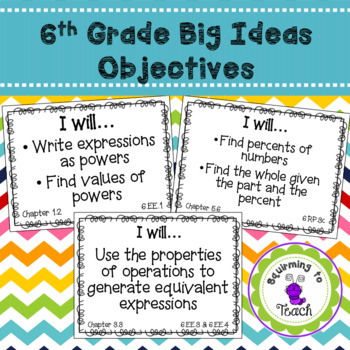Grade 6 Big Ideas Math Objectives
Squirming to Teach
393 Followers
Grade Levels
5th - 7th
Subjects
Resource Type
Standards
CCSS6.G.A.1
CCSS6.G.A.2
CCSS6.G.A.3
CCSS6.G.A.4
CCSS6.SP.A.1
Formats Included
- PDF
Pages
59 pages
Squirming to Teach
393 Followers
What educators are saying
This was a great resource since it aligns with Big Ideas and made it so easy for me to display and not waste time writing the standard each day.
Description
Easy and prep free resource. Just print and post in your classroom the day of the lesson! These standards are aligned for Big Ideas Math (green book) grade 6!
I also included the chapter section and common core standard number at the bottom of each objective.
Total Pages
59 pages
Answer Key
Does not apply
Teaching Duration
1 Year
Report this resource to TPT
Reported resources will be reviewed by our team. Report this resource to let us know if this resource violates TPT’s content guidelines.
Standards
to see state-specific standards (only available in the US).
CCSS6.G.A.1
Find the area of right triangles, other triangles, special quadrilaterals, and polygons by composing into rectangles or decomposing into triangles and other shapes; apply these techniques in the context of solving real-world and mathematical problems.
CCSS6.G.A.2
Find the volume of a right rectangular prism with fractional edge lengths by packing it with unit cubes of the appropriate unit fraction edge lengths, and show that the volume is the same as would be found by multiplying the edge lengths of the prism. Apply the formulas 𝘝 = 𝘭 𝘸 𝘩 and 𝘝 = 𝘣 𝘩 to find volumes of right rectangular prisms with fractional edge lengths in the context of solving real-world and mathematical problems.
CCSS6.G.A.3
Draw polygons in the coordinate plane given coordinates for the vertices; use coordinates to find the length of a side joining points with the same first coordinate or the same second coordinate. Apply these techniques in the context of solving real-world and mathematical problems.
CCSS6.G.A.4
Represent three-dimensional figures using nets made up of rectangles and triangles, and use the nets to find the surface area of these figures. Apply these techniques in the context of solving real-world and mathematical problems.
CCSS6.SP.A.1
Recognize a statistical question as one that anticipates variability in the data related to the question and accounts for it in the answers. For example, “How old am I?” is not a statistical question, but “How old are the students in my school?” is a statistical question because one anticipates variability in students’ ages.





